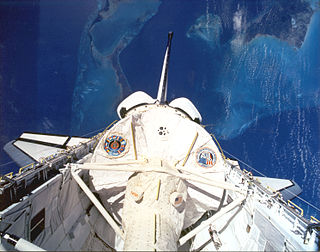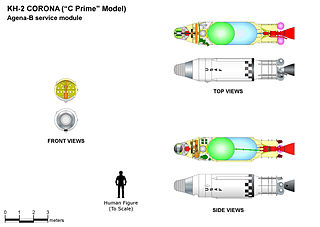
STS-50 was a United States Space Shuttle mission, the 12th mission of the Columbia orbiter. Columbia landed at Kennedy Space Center for the first time ever due to bad weather at Edwards caused by the remnants of Hurricane Darby.

STS-54 was a Space Transportation System mission using Space Shuttle Endeavour. This was the third flight for Endeavour, and was launched on 13 January 1993.

STS-76 was NASA's 76th Space Shuttle mission, and the 16th mission for Atlantis. STS-76 launched on 22 March 1996 at 3:13 am EST from Kennedy Space Center launch pad 39B. STS-76 lasted over 9 days, traveled about 3,800,000 miles (6,100,000 km) while orbiting Earth an estimated 145 times, and landing at 5:28 am PST on 31 March 1996 at Edwards Air Force Base runway 22.

STS-83 was a NASA Space Shuttle mission flown by Columbia. It was a science research mission that achieved orbit successfully, but the planned duration was a failure due to a technical problem with a fuel cell that resulted in the abort of the 15 day duration. Columbia returned to Earth just shy of four days. The mission was re-flown as STS-94 with the same crew later that year.

STS-94 was a mission of the United States Space Shuttle Columbia, launched on 1 July 1997.

STS-89 was a Space Shuttle mission to the Mir space station flown by Space Shuttle Endeavour, and launched from Kennedy Space Center, Florida on 22 January 1998.

The Indian Space Research Organisation or is the national space agency of the Republic of India, headquartered in Bengaluru. It operates under Department of Space (DoS) which is directly overseen by the prime minister of India while chairman of ISRO acts as executive of DoS as well. ISRO is the primary agency in India to perform tasks related to space based applications, space exploration and development of related technologies. It is one of six government space agencies in the world which possess full launch capabilities, deploy cryogenic engines, launch extraterrestrial missions and operate large fleets of artificial satellites.
Bion 8 or Kosmos 1887 was a Bion satellite.
The Indian Human Spaceflight Programme (HSP) was initiated in 2007 by the Indian Space Research Organisation (ISRO) to develop the technology needed to launch crewed orbital spacecraft into low Earth orbit. The first crewed flight was planned with a spacecraft called Gaganyaan for December 2021 on a GSLV Mark III rocket.

The Space Capsule Recovery Experiment is an Indian experimental spacecraft which was launched at 03:53 UTC on January 10, 2007 from Sriharikota by the Indian Space Research Organisation (ISRO). The launch was conducted using the PSLV C7 rocket, along with three other satellites. It remained in orbit for 12 days before re-entering the Earth's atmosphere and splashing down into the Bay of Bengal at 04:16 UTC on January 22.
Gaganyaantransl. "Sky Craft") is an Indian crewed orbital spacecraft intended to be the formative spacecraft of the Indian Human Spaceflight Programme. The spacecraft is being designed to carry three people, and a planned upgraded version will be equipped with rendezvous and docking capability. In its maiden crewed mission, Indian Space Research Organisation (ISRO)'s largely autonomous 3.7-tonne (8,200 lb) capsule will orbit the Earth at 400 km (250 mi) altitude for up to seven days with a two or three-person crew on board. The crewed vehicle was originally planned to be launched on ISRO's GSLV Mk III in December 2021, but this has since been delayed to no earlier than 2022. This Hindustan Aeronautics Limited (HAL) manufactured crew module had its first un-crewed experimental flight on 18 December 2014. As of May 2019, design of the crew module has been completed. Defence Research and Development Organisation (DRDO) will provide support for critical human-centric systems and technologies like space grade food, crew healthcare, radiation measurement and protection, parachutes for the safe recovery of the crew module and fire suppression system.
The Institute for Unmanned Space Experiment Free Flyer (USEF) (財団法人無人宇宙実験システム研究開発機構) was a Japanese space agency, which was founded by the Ministry of International Trade and Industry in 1986. Unlike NASDA, ISAS, and NAL, it was not included in the JAXA organization, which was founded in 2003. The chairperson is Ichiro Taniguchi.

Kounotori 2, also known as HTV-2, was launched in January 2011 and was the second Japanese H-II Transfer Vehicle to resupply the International Space Station (ISS). It was launched by the H-IIB Launch Vehicle No. 2 manufactured by Mitsubishi Heavy Industries (MHI) and JAXA. After the supplies were unloaded, Kounotori 2 was loaded with waste material from ISS, including used experiment equipment and used clothes. Kounotori 2 was then unberthed and separated from the ISS and burned up upon reentering the atmosphere on 30 March 2011.

Scientific research on the International Space Station is a collection of experiments that require one or more of the unusual conditions present in low Earth orbit. The primary fields of research include human research, space medicine, life sciences, physical sciences, astronomy and meteorology. The 2005 NASA Authorization Act designated the American segment of the International Space Station as a national laboratory with the goal of increasing the use of the ISS by other federal agencies and the private sector.

Discoverer 18, also known as Corona 9013, was an American optical reconnaissance satellite launched on 7 December 1960 at 20:24:00 GMT. It was the first successful, and the third of ten total Corona KH-2 satellites, based on the Agena-B.

The Crew Module Atmospheric Re-entry Experiment (CARE) is an experimental test vehicle for the Indian Space Research Organisation's future ISRO orbital vehicle called Gaganyaan. It was launched successfully on 18 December 2014 from the Second Launch Pad of the Satish Dhawan Space Centre, by a GSLV Mk III designated by ISRO as the LVM 3X CARE mission. Total cost of mission was ₹155 crore. Cost of launch vehicle and CARE module was ₹140 crore and ₹15 crore.
Shukrayaan-1 is a proposed orbiter to Venus by the Indian Space Research Organisation (ISRO) to study the surface and atmosphere of Venus.

Kounotori 7 (こうのとり7号機), also known as HTV-7 is the seventh flight of the H-II Transfer Vehicle (HTV), an uncrewed cargo spacecraft launched on 22 September 2018 to resupply the International Space Station.

Discoverer 2 was an American optical reconnaissance satellite launched on 13 April 1959 at 21:18:39 GMT, the second of three test flights of the Corona KH-1 spy satellite series. Discoverer 2 was the first satellite to be stabilized in orbit in all three axes and to be maneuvered on command from the earth. Though it carried no film and thus conducted no surveillance, Discoverer 2 was both the first satellite equipped with a reentry capsule and the first to return a payload from orbit. A timing error caused the reentry capsule to land near Spitzbergen, Norway, rather than Hawaii; the capsule was never recovered and may have entered Soviet possession.

The Human Space Flight Centre (HSFC) is a body under Indian Space Research Organisation (ISRO) to coordinate Indian Human Spaceflight Programme. The agency will be responsible for implementation of the Gaganyaan project. The first crewed flight is planned for December 2021 on a home-grown GSLV-III rocket.
















